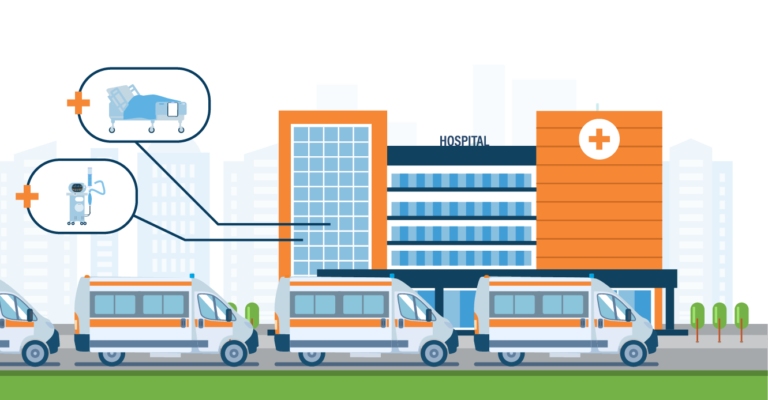Capacity, Capability and Emergency Management Plan
What is Medical Surge?
The COVID-19 pandemic has stressed the ability of healthcare facilities to provide an effective and coordinated response to this complex incident. The mass disruption of public health and medical services has highlighted the need for cohesive strategies that focus on management systems for major public health and medical response.
What is the difference between Medical Surge Capacity and Capability?
According to the U.S. Department of Health and Human Servicesi, “Medical surge describes the ability to provide adequateii medical evaluation and care during events that exceed the limits of the normal medical infrastructure of an affected community. It encompasses the ability of HCOs to survive a hazard impact and maintain or rapidly recover operations that were compromised (a concept known as medical system resiliency).”

“Medical Surge Capacity is primarily about the systems and processes that influence specific asset quantity.”
Medical Surge Capacity is the ability to evaluate and care for an increased volume of patients, overly exceeding normal operating capacity. This concept reaches further than direct patient care into laboratory studies or epidemiological investigations. The focus is in identifying numbers of hospital beds, personnel, pharmaceuticals, supplies, and equipment.
The following need to be examined:

“Surge Capability also includes patient problems that require special intervention to protect medical providers, other patients, and the integrity of the HCO.”

Medical Surge Capability is the ability to manage patients requiring unusual or very specialized medical evaluation and care. Surge requirements span the range of specialized medical services (expertise, information, procedures, equipment, or personnel) that are not normally available at the location where they are needed (e.g., pediatric care provided at non-pediatric facilities).
What is an Emergency Management Program?
According to the U.S. Department of Health and Human Services3, “Emergency management describes the science of managing complex systems and multidisciplinary personnel to address extreme events, across all hazards, and through the phases of mitigation, preparedness, response, and recovery.”
- Mitigation – reduce or eliminate occurrence or impact (prior to impact)
- Preparedness – build organizational resiliency, capacity and capabilities
- Response – actions taken to address impact
- Recovery – restoration after incident
What are the Demands encountered during an Incident Response?
During the first stages of incident response, the efforts are concentrated on demands that are generated by the hazard. For example, during COVID-19 the hazard generated demands included the need to evaluate and treat victims as well as control the spread of disease. At the same time, the response itself generated demands. The response generated demands included the need to coordinate disparate resources, to process widely dispersed data into accurate epidemiological information, to coordinate the public message, and to protect healthcare workers. 4 Frequently, the focus on the Hazard Generated Demands causes the luck of attention on the Response Generated Demands. The oversight of Response Generated Demands becomes detrimental to the effectiveness of the overall response. A successful response should assess and anticipate Response Generated Demands and address them at the same time as Hazard Generated Demands.

Is your facility ready for COVID-19?

Are you looking for a way to better operate your facility during COVID-19? We offer surge capacity and capability solutions to include Surge Teams, Portable Structures, Temperature Checks, Telehealth, Community Paramedicine, Staffing and Consulting to match your needs.
The AB Med team is here for your facility and your community. We have the knowledge and experience to help you navigate through the challenges into a successful medical surge plan. Let’s Connect.
COVID-19 Disclaimer
At AB Med, accuracy is our highest priority, and everything we publish is up-to-date based on research and news at the time of release. However, due to the continually evolving nature of COVID-19, we are aware that available data changes quickly. The available data and recommendations may have changed since this article’s publication. Please check the CDC, WHO, and your local health department for the most current recommendations and news.
We at AB Med are excited to talk to you, Contact us
REFERENCES & RESOURCES
- U.S. Department of Health and Human Services (2019). Medical Surge Capacity and Capability Handbook. [online] Phe.gov. Available at: https://www.phe.gov/Preparedness/planning/mscc/handbook/chapter1/Pages/whatismedical surge.aspx
- Throughout this document, the term adequate implies a system, process, procedure, or quantity that will achieve a defined response objective.
- U.S. Department of Health and Human Services (2019). Medical Surge Capacity and Capability Handbook. [online] Phe.gov. Available at: https://www.phe.gov/Preparedness/planning/mscc/handbook/Pages/appendixc.aspx [Accessed 23 Apr. 2020].
- U.S. Department of Health and Human Services (2019). Medical Surge Capacity and Capability Handbook. [online] Phe.gov. Available at: https://www.phe.gov/Preparedness/planning/mscc/handbook/chapter1/Pages/emergencyma nagement.aspx
By: Erik McLaughlin MD, MPH and Aikaterini Papadopoulou, B.Arch






